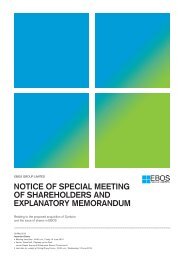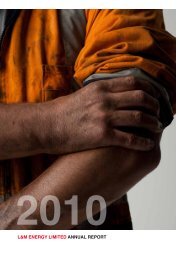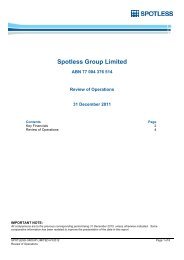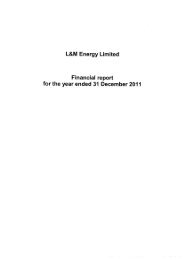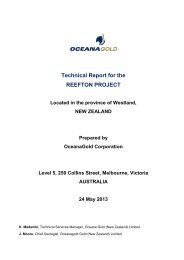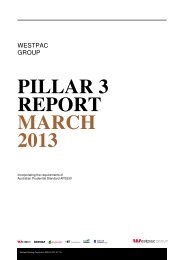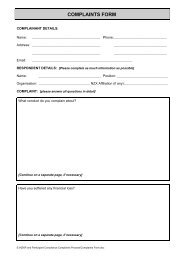NZSX/ NZDX Listing Rules APPENDIX 1 Part A (Rules 10.4.2 ... - NZX
NZSX/ NZDX Listing Rules APPENDIX 1 Part A (Rules 10.4.2 ... - NZX
NZSX/ NZDX Listing Rules APPENDIX 1 Part A (Rules 10.4.2 ... - NZX
You also want an ePaper? Increase the reach of your titles
YUMPU automatically turns print PDFs into web optimized ePapers that Google loves.
THE 2004 AUSTRALASIAN CODE FOR REPORTING EXPLORATION RESULTS, MINERAL RESOURCES AND ORE RESERVES (THE JORC CODE)<br />
Reporting of selected information such as isolated assays,<br />
isolated drill holes, assays of panned concentrates or<br />
supergene enriched soils or surface samples, without<br />
placing them in perspective is unacceptable.<br />
Table 1 is a check list and guideline to which those<br />
preparing reports on Exploration Results, Mineral<br />
Resources and Ore Reserves should refer. The check<br />
list is not prescriptive and, as always, relevance and<br />
materiality are overriding principles which determine<br />
what information should be publicly reported.<br />
18.It is recognised that it is common practice for a company<br />
to comment on and discuss its exploration in terms of<br />
target size and type. Any such information relating to<br />
exploration targets must be expressed so that it cannot<br />
be misrepresented or misconstrued as an estimate of<br />
Mineral Resources or Ore Reserves. The terms Resource(s)<br />
or Reserve(s) must not be used in this context. Any<br />
statement referring to potential quantity and grade of<br />
the target must be expressed as ranges and must include<br />
(1) a detailed explanation of the basis for the statement,<br />
and (2) a proximate statement that the potential quantity<br />
and grade is conceptual in nature, that there has been<br />
insufficient exploration to define a Mineral Resource and<br />
that it is uncertain if further exploration will result in the<br />
determination of a Mineral Resource.<br />
REPORTING OF MINERAL RESOURCES<br />
19. A ‘Mineral Resource’ is a concentration or occurrence<br />
of material of intrinsic economic interest in or on the<br />
Earth’s crust in such form, quality and quantity that<br />
there are reasonable prospects for eventual economic<br />
extraction. The location, quantity, grade, geological<br />
characteristics and continuity of a Mineral Resource<br />
are known, estimated or interpreted from specific<br />
geological evidence and knowledge. Mineral Resources<br />
are sub-divided, in order of increasing geological<br />
confidence, into Inferred, Indicated and Measured<br />
categories.<br />
Portions of a deposit that do not have reasonable<br />
prospects for eventual economic extraction must not<br />
be included in a Mineral Resource. If the judgement as<br />
to ‘eventual economic extraction’ relies on untested<br />
practices or assumptions, this is a material matter which<br />
must be disclosed in a public report.<br />
The term ‘Mineral Resource’ covers mineralisation,<br />
including dumps and tailings, which has been<br />
identified and estimated through exploration and<br />
sampling and within which Ore Reserves may be<br />
defined by the consideration and application of the<br />
Modifying Factors.<br />
The term ‘reasonable prospects for eventual<br />
economic extraction’ implies a judgement (albeit<br />
preliminary) by the Competent Person in respect of<br />
the technical and economic factors likely to<br />
influence the prospect of economic extraction,<br />
including the approximate mining parameters. In<br />
other words, a Mineral Resource is not an inventory<br />
of all mineralisation drilled or sampled, regardless<br />
of cut-off grade, likely mining dimensions, location<br />
or continuity. It is a realistic inventory of<br />
mineralisation which, under assumed and justifiable<br />
technical and economic conditions, might, in whole<br />
or in part, become economically extractable.<br />
Where considered appropriate by the Competent<br />
Person, Mineral Resource estimates may include<br />
material below the selected cut-off grade to ensure<br />
that the Mineral Resources comprise bodies of<br />
mineralisation of adequate size and continuity to<br />
properly consider the most appropriate approach to<br />
mining. Documentation of Mineral Resource<br />
estimates should clearly identify any diluting material<br />
included, and Public Reports should include<br />
commentary on the matter if considered material.<br />
Any material assumptions made in determining the<br />
‘reasonable prospects for eventual economic<br />
extraction’ should be clearly stated in the Public Report.<br />
Interpretation of the word ‘eventual’ in this context<br />
may vary depending on the commodity or mineral<br />
involved. For example, for some coal, iron ore,<br />
bauxite and other bulk minerals or commodities, it<br />
may be reasonable to envisage ‘eventual economic<br />
extraction’ as covering time periods in excess of 50<br />
years. However for the majority of gold deposits,<br />
application of the concept would normally be<br />
restricted to perhaps 10 to 15 years, and frequently<br />
to much shorter periods of time.<br />
Any adjustment made to the data for the purpose of<br />
making the Mineral Resource estimate, for example<br />
by cutting or factoring grades, should be clearly stated<br />
and described in the Public Report.<br />
Certain reports (eg: inventory coal reports, exploration<br />
reports to government and other similar reports not<br />
intended primarily for providing information for<br />
investment purposes) may require full disclosure of<br />
all mineralisation, including some material that does<br />
not have reasonable prospects for eventual economic<br />
extraction. Such estimates of mineralisation would<br />
not qualify as Mineral Resources or Ore Reserves in<br />
terms of the JORC Code (refer also to the guidelines<br />
to Clauses 5 and 37).<br />
20. An ‘Inferred Mineral Resource’ is that part of a Mineral<br />
Resource for which tonnage, grade and mineral content<br />
can be estimated with a low level of confidence. It is<br />
inferred from geological evidence and assumed but not<br />
Note: Code is in normal typeface, guidelines are in indented italics, definitions are in bold.<br />
~ 7 ~



